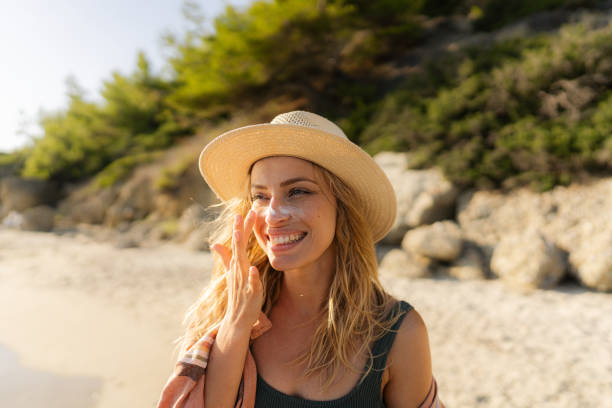
Sun block is a skincare product that helps protect the skin from harmful effects of the sun. It acts as a barrier against ultraviolet (UV) rays that can cause damage such as Sun block , dark spots, early aging, and even skin cancer. People of all skin types and ages should use sun block regularly to keep their skin safe and healthy.
Why Sun Protection Matters
The sun emits two main types of UV rays – UVA and UVB. UVA rays go deep into the skin and can lead to premature aging, while UVB rays affect the top layer and are mainly responsible for sunburn. Long-term exposure to these rays without protection can lead to serious skin problems. This is why using sun block is very important every day, even when it is cloudy or cold outside.
What is Sun Block Made Of
Sun block contains ingredients that either absorb or reflect UV rays. These ingredients are divided into two main types – physical and chemical. Physical ingredients such as zinc oxide and titanium dioxide form a layer on the skin that reflects the rays. Chemical ingredients like avobenzone and oxybenzone absorb the UV rays and prevent them from penetrating the skin. Both types are effective, and many products use a combination of both.
Benefits of Using Sun Block
-
Protects from Sunburn
Sunburn is painful and damaging. Sun block helps prevent this by blocking harmful rays from reaching your skin. -
Reduces Risk of Skin Cancer
Regular use of sun block lowers the risk of skin cancer by limiting exposure to harmful radiation. -
Prevents Premature Aging
Sun rays cause early wrinkles, fine lines, and spots. Sun block protects the skin from aging signs by shielding it from UVA rays. -
Keeps Skin Tone Even
Sun exposure can cause uneven skin tone or dark patches. Using sun block helps maintain a smooth and even complexion. -
Protects All Skin Types
Whether you have dry, oily, sensitive, or combination skin, there are sun blocks available for every skin type. This makes it easy to protect your skin without causing irritation.
When and How to Use Sun Block
Sun block should be applied 15 to 30 minutes before going outside. This allows the ingredients to start working. It should be reapplied every two hours, especially if you are sweating, swimming, or wiping your face. Even if your sun block is water-resistant, it needs to be reapplied after water activities.
Apply a generous amount to all exposed areas including the face, neck, ears, arms, and legs. Do not forget often-missed spots like the back of the neck, hands, and feet.
Choosing the Right Sun Block
There are many types of sun block available. When choosing the right one, look for these features:
-
Broad-spectrum protection: This protects against both UVA and UVB rays.
-
SPF rating: SPF stands for Sun Protection Factor. Higher numbers offer more protection. SPF 30 or more is recommended for daily use.
-
Suitable for your skin type: If you have oily skin, choose a non-comedogenic formula. For dry skin, look for moisturizing ingredients.
Types of Sun Block
-
Lotion – Easy to spread and good for large areas.
-
Cream – Best for dry skin and face.
-
Gel – Suitable for oily skin or hairy areas.
-
Spray – Easy to apply but can be missed in some spots.
-
Stick – Great for small areas like lips, nose, and around the eyes.
Sun Block for Children
Children have sensitive skin, so it is important to choose a sun block specially made for them. These usually have physical ingredients and are gentle on the skin. Parents should apply sun block to children every day they are outside, especially during play or outdoor school activities.
Myths About Sun Block
-
Myth: I don’t need sun block on cloudy days.
UV rays pass through clouds, so sun block is still needed. -
Myth: Dark skin does not need sun block.
All skin tones are at risk of damage and should use protection. -
Myth: Sun block is only for summer.
UV rays are present all year, even in winter or when indoors near windows.
Common Mistakes in Using Sun Block
Many people use sun block but still get sun damage because they make some common mistakes:
-
Applying too little.
-
Not reapplying after swimming or sweating.
-
Missing key areas like ears, neck, and feet.
-
Using expired products.
Avoiding these mistakes will ensure proper protection.
Sun Block and Makeup
There are many sun block options available that can be worn under makeup. Some foundations also contain SPF. However, it’s still a good idea to apply sun block before makeup to get full protection.
Environmental Impact
Some sun block ingredients can harm marine life. If you are going swimming in natural water bodies, look for sun blocks labeled “reef-safe” or eco-friendly. These do not contain harmful chemicals and help protect the environment while also protecting your skin.
Daily Use for Healthy Skin
Using sun block daily is one of the simplest and most effective ways to maintain skin health. Whether you are indoors with sunlight coming through windows, or outdoors under direct sun, protection is always important. A simple habit like this can prevent long-term damage and keep your skin looking young and fresh.
Conclusion
Sun block is an essential part of daily skin care. It protects against sunburn, skin aging, dark spots, and even skin cancer. It is suitable for all ages and skin types. Choosing the right sun block and using it properly will keep your skin safe, smooth, and beautiful for years to come. Make it a daily habit and enjoy the benefits of healthy skin.
Comments on “Importance and Benefits of Using Sun Block for Healthy Skin”